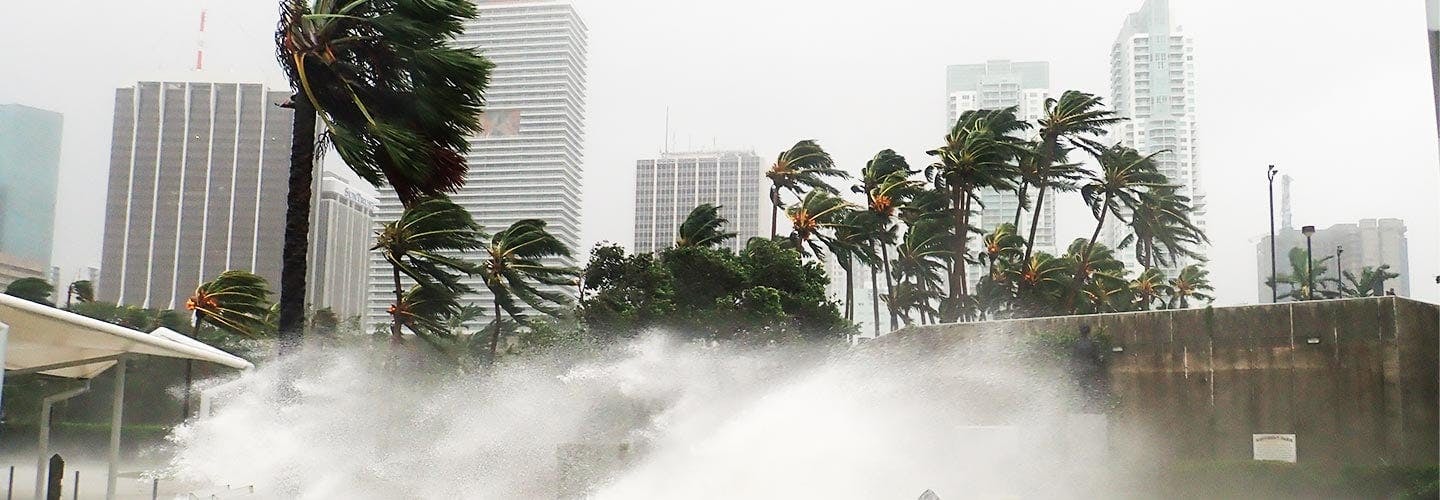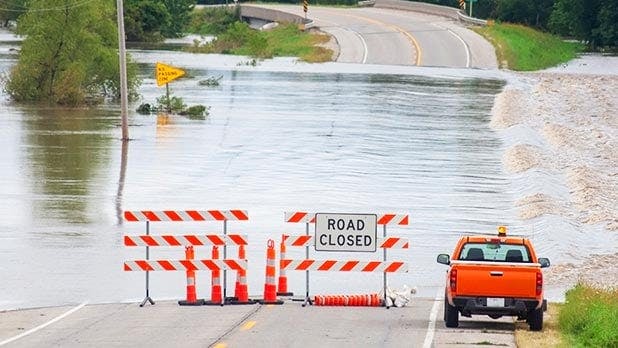Hurricane insurance resources + what you need to know
- Planning ahead
- Crisis management
- Homeowners insurance
- Auto insurance

Hurricanes have wreaked havoc on communities across the country for all of recorded history, and unfortunately these powerful weather phenomena are only slated to continue. In the United States, hurricane season starts on June 1 and lasts all the way through the end of November, impacting many parts of the country with varying degrees of destruction.
The National Weather Service estimates that every year, on average, 12 tropical storms form over the Atlantic Ocean, Caribbean Sea and the Gulf of Mexico, six of which become hurricanes. This puts Florida, Texas, North Carolina and Louisiana especially at risk, though it’s important to note that the Western states are not free from risk. The Pacific Ocean also gets an average of three yearly tropical storms, two of which meteorologists expect to become hurricanes.
When it comes to minimizing risk and protecting yourself, your loved ones and your property in the event of a hurricane, insurance resources are critical. That’s why we’ve put together this in-depth guide on what you need to do to keep your family safe in the storm, stay covered with the right insurance options and prepare your home for what may come.
Rest easy with the right homeowners insurance
Reduce your risk, insure your things and stay protected
1. Know what to expect
A hurricane happens when a rotating tropical storm, made up of strong winds and heavy rain, comes into contact with warm ocean waters. This makes the storm gather heat and energy, thereby picking up enough speed to travel across states or the entire length of the eastern coast for sometimes more than two weeks at a time bringing tidal surges, flooding, mudslides and more.
Take a look at the Saffir-Simpson Hurricane Wind Scale. The National Hurricane Center categorizes hurricanes and estimates potential damages according to the scale. When a hurricane forms, the category will be shared to help you make decisions about what precautions to take.
Category 1 | 74-94 mph winds | Very dangerous winds will produce some damage: Well-constructed frame homes could have damage to roof, shingles, vinyl siding and gutters. Large branches of trees will snap and shallowly rooted trees may be toppled. Extensive damage to power lines and poles likely will result in power outages that could last a few to several days.
Category 2 | 96-110 mph winds | Extremely dangerous winds will cause extensive damage: Well-constructed frame homes could sustain major roof and siding damage. Many shallowly rooted trees will be snapped or uprooted and block numerous roads. Near-total power loss is expected with outages that could last from several days to weeks.
Category 3 | 111-129 mph winds | Devastating damage will occur: Well-built framed homes may incur major damage or removal of roof decking and gable ends. Many trees will be snapped or uprooted, blocking numerous roads. Electricity and water will be unavailable for several days to weeks after the storm passes.
Category 4 | 130-156 mph winds | Catastrophic damage will occur: Well-built framed homes can sustain severe damage with loss of most of the roof structure and/or some exterior walls. Most trees will be snapped or uprooted and power poles downed. Fallen trees and power poles will isolate residential areas. Power outages will last weeks to possibly months. Most of the area will be uninhabitable for weeks or months.
Category 5 | 157 mph or higher winds | Catastrophic damage will occur: A high percentage of framed homes will be destroyed, with total roof failure and wall collapse. Fallen trees and power poles will isolate residential areas. Power outages will last for weeks to possibly months. Most of the area will be uninhabitable for weeks or months.
2. Prepare your home as best you can and consider a professional inspection
Of course, the most important thing is for you and your family to stay safe, but you can try and minimize risk as well as damage to your home by taking the following precautions.
Take care of your roof in the lead-up to the hurricane. Fixing loose shingles and trimming trees will keep your house safer from wind damage. Another benefit to trimming your trees is that there will be fewer branches that threaten your home’s frame.
Permanent roll-down or accordion shutters are the best protection against high winds and rain. They’re affixed to the exterior of your home’s windows and doors, so you can close them at a moment’s notice — and properly installed shutters may even lower your insurance premiums while reducing damage risk.
If you do get shutters installed, you need to have a clear plan and protocol in place with your storm shutter company. The VIU by HUB Advisory Team can review these details and determine whether your carrier is willing to send a professional to conduct a home inspection. This person can assess your current situation and potential precautions you can take to protect your property, resulting in additional homeowners credits and reduced premiums for proactive safeguarding.
If you don’t have specialty shutters, you can use ½-inch marine plywood, cut in advance to fit each of your windows. Remember to mark which board fits which window and pre-drill holes every 18 inches for screws. It’s best to do this well in advance of a storm so they can be installed quickly when they’re needed.
3. Create an inventory and back up any important data
It’s a good idea to develop an inventory of your personal possessions such as furniture, appliances, clothing, fine art and valuables. You’ll want your records saved and up-to-date, and in the event of a claim, a videotape or photographs of belongings are an excellent source of documentation.
Store these materials in a safe place with your insurance and title documents, upload them to the cloud and send a copy to a friend or relative who lives out of the area, as well as your insurance agent. To make the most of your coverage, ensure that this inventory is updated every six months.
4. Pack an emergency supply kit and keep it handy
Natural disaster relief experts recommend an emergency kit that includes these items in your road-ready vehicle or by the door for easy access:
- Flashlight and spare batteries
- Rain poncho
- Fire extinguisher
- Energy-dense foods such as trail mix, granola bars, dried fruit, etc.
- Blankets
- Water
- Dry change of clothing
- Spare fuses
- Windshield washer fluid
- First aid kit
5. Leave when it’s time according to your evacuation plan
When authorities call for evacuation, gather your family and leave as soon as possible. If there’s time before you go, clear out and defrost your refrigerator and/or freezer in case you lose power. Store perishables in a cooler to bring with you when you leave and remember to lock your windows and your doors. Only return home when officials determine it is safe to do so.
Take your emergency supply kit, along with a waterproof folder for important papers including your driver’s license, medical documents, and any insurance-related information like your house title, property inventories, emergency contacts and how to reach your carrier’s claims reporting department.
Experts recommend that you take these other important papers:
- Birth and marriage certificates
- Social Security card and passports
- Immunization records
- Bank account and credit card numbers
- Vehicle titles
- Military service papers
- Wills, deeds, stocks and bonds
- Irreplaceable photographs
Our advisory team also recommends the following list:
- Cash and credit cards
- Medications (prescription and non-prescription such as allergy and pain relief)
- Eyeglasses, contact lenses and cleaning/storage solution
- Clothing and bedding
- Sturdy shoes
- Hygiene items (toothbrush, toothpaste, deodorant, etc.)
- Cell phone and laptop chargers
- Computer back-up of important electronic data
- Radio and batteries
- Emergency blanket
- Work gloves
- Multi-purpose tool
- Antibacterial wipes
- Dust mask
- Notepad and pen/pencil
- Copy of family emergency plan
If you’re evacuating with infants or children, be sure to pack items like a favorite stuffed animal or doll as well as activities like crayons, coloring books and reading material in addition to their necessities such as diapers, formula and baby food. These items can help to make them feel more at ease. If you’re evacuating with a pet, be sure to pack extra food and water, veterinary information, medicines and their collar and leash as well as a portable cage or carrier.
Review the FEMA Evacuation Guidelines to allow for enough time to pack and inform friends and family if you need to leave your home.
Set up the right coverage for your circumstances and risks
Basic homeowners insurance can only go so far in protecting you against hurricane damage. Our advisory team can walk you through your policy and clarify everything you’re insured for, and where you might want to consider extending your coverage. Other Structures Coverage can insure your fence, pool, shed or gazebo, for instance, while Loss of Use Coverage pays for living arrangements if a covered loss renders your home unlivable. If you live in a hurricane-prone area, you should also think about adding a Wind and Hail Damage Deductible.
Floods are another major risk in the wake of hurricanes that are not covered by a standard homeowners insurance policy. Our advisors can recommend flood insurance that’s tailored to your area and specific needs, while also offering hurricane insurance resources and expert insights into the claims and damage documentation process with your particular insurance provider.


